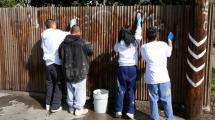Youth who receive special education services under the Individuals with Disabilities Education Act (IDEA 2004) and especially young adults of transition age, should be involved in planning for life after high school as early as possible and no later than age 16. Transition services should stem from the individual youth’s needs and strengths, ensuring that planning takes into account his or her interests, preferences, and desires for the future.
Federal Programs
The 2022 All In: The Federal Strategic Plan to Prevent and End Homelessness (PDF, 104 pages) developed by the U.S. Interagency Council on Homelessness suggests that six pillars, consisting of three foundations (equity, evidence, and collaboration) and three solutions (housing and supports, homelessness response, and prevention) are consistently identified as necessary to address and prevent homelessness by increasing availability of and access to housing, economic security, health care, and stability.
Building an efficient and effective homeless services system will require partners at all levels to understand and address disparities. Examples of a variety of federal programs that strive to address these areas and support youth experiencing homelessness and youth who have run away include the following:
The Runaway and Homeless Youth (RHY)—Prevention Demonstration Project (RHY-PDP)
Ending youth homelessness requires both addressing the immediate needs of youth who are experiencing homelessness and, just as importantly, preventing youth from becoming homeless in the first place.
The purpose of RHY-PDP is to address the second requirement, prevention. Projects funded increase protective factors and give youth, young adults, and their families the resources they need to avoid homelessness. Through this funding opportunity, 10 cooperative agreements were awarded to plan and implement prevention services designed specifically for youth and young adults who are at risk of experiencing homelessness or housing instability and their families.
Projects funded through this program prevent youth and young adults under age 22 from experiencing homelessness. They develop partnerships to accomplish the following goals:
- Identify young people at risk of experiencing homelessness.
- Design and develop a comprehensive community-based plan to prevent youth homelessness.
- Promote equity in the delivery of services.
- Implement prevention services for youth and young adults who are at risk of homelessness and their families.
- Evaluate the implementation of prevention services and interventions.
Basic Center Program
The Basic Center Program (BCP) was authorized in the Runaway and Homeless Youth Act and is supported by the Family and Youth Service Bureau (FYSB) within the Administration for Children and Families (ACF). BCP helps create and strengthen community-based programs that meet the immediate needs of runaway youth and youth experiencing homelessness under 18 years old by providing up to 21 days of shelter, food, clothing, and medical care; individual, group, and family counseling; crisis intervention, recreation programs, and aftercare services. One goal of BCP is to reunite young people with their families or locate appropriate alternative placements.
Transitional Living Program
The Transitional Living Program (TLP) was authorized in the Runaway and Homeless Youth Act and is supported by the FYSB within the ACF. It provides long-term residential services to youth experiencing homelessness between ages 16 and 22. TLP provides living arrangements for youth in host families, group homes, maternity group homes, and supervised apartments owned or rented by the program. In addition the program provides the following:
- Safe, stable living accommodations
- Basic life skills building, including consumer education, budgeting, housekeeping, food preparation, and parenting skills
- Educational opportunities, such as GED preparation, postsecondary training, and vocational education
- Job attainment services, such as career counseling and job placement
- Mental health care, including individual and group counseling
- Physical health care, such as physicals, health assessments, and emergency treatment
Maternity Group Homes for Pregnant and Parenting Youth Program
Maternity Group Homes (MGH), supported by the FYSB within the ACF, provide support for pregnant and/or parenting youth experiencing homelessness between ages 16 and 22, as well as their dependent children. The MGH program provides similar services to TLP, as well as services that incorporate positive youth development and teach parenting skills, child development, family budgeting, and health and nutrition.
Street Outreach Program
The Street Outreach Program (SOP), supported by the FYSB within the ACF, supports work with youth experiencing homelessness, runaway youth, and street youth to help them find stable housing and services. SOP focuses on developing relationships between outreach workers and young people that allow them to rebuild connections with caring adults. The ultimate goal is to prevent the sexual exploitation and abuse of youth on the streets. The services include street-based education and outreach, access to emergency shelter, survival aid, treatment and counseling, crisis intervention, and follow-up support.
Maternal, Infant, and Early Childhood Home Visiting Program
The Maternal, Infant, and Early Childhood Home Visiting (MIECHV) Program supports pregnant people and parents with young children who live in communities that face greater risks and barriers to achieving positive maternal and child health outcomes. Families choose to participate in home visiting programs and partner with health, social service, and child development professionals to set and achieve goals that improve their health and well-being. Home visitors use a range of strategies to meet the specific needs of families, including families who are experiencing homelessness or do not have access to stable housing. Strategies may include the following:
- Screening families for housing status and linking families to transitional housing, utility programs, and other economic supports
- Conducting visits in shelters or other locations and during nontraditional hours that are best for families
- Educating caregivers about healthy home environments that support child development
- Supporting families across time in taking steps to meet their goals for economic well-being
McKinney-Vento Education for Homeless Children and Youth Program or Education for Homeless Children and Youth Grants (PDF, 2 pages)
Formula grants are provided to the 50 states, the District of Columbia, and Puerto Rico, based on each state’s share of Title I, Part A, funds. Outlying areas and the Bureau of Indian Affairs also receive funds. The program provides funds for an office to coordinate the education of children and youth experiencing homelessness in each state; helps state education agencies ensure that children experiencing homelessness, including preschoolers and youths, have equal access to free and appropriate public education; and mandates that states review and revise laws and practices that impede such equal access. Learn more about the program on the U.S. Department of Education website.
Foster Youth to Independence Program
The U.S. Department of Housing and Urban Development’s (HUD’s) Foster Youth to Independence (FYI) initiative makes Housing Choice Voucher (HCV) assistance available to Public Housing Agencies (PHAs) in partnership with Public Child Welfare Agencies (PCWAs). Under FYI, PHAs provide HCV assistance on behalf of youth at least 18 years and not more than 24 years (i.e., have not reached their 25th birthday) who left foster care, or will leave foster care within 90 days, in accordance with a transition plan described in Section 475(5)(H) of the Social Security Act and are homeless or are at risk of becoming homeless at age 16 or older. In general, a youth receiving an FYI voucher would pay 30 percent of their monthly adjusted income toward rent, and the voucher would pay the remaining portion of the rent. As required by statute, an FYI voucher issued to such a youth may be used to provide only housing assistance for the youth for a maximum of 36 months. However, youth may receive up to an additional 24 months of assistance if they meet the requirements of the Fostering Stable Housing Opportunities amendments (87 FR 3570).
Continuum of Care Homeless Assistance Programs
HUD supports Continuum of Care (CoC) homeless assistance programs, with a goal of reducing the incidence of homelessness in CoC communities, by assisting individuals and families experiencing homelessness in quickly transitioning to self-sufficiency and permanent housing, as authorized under Title IV of the McKinney-Vento Homeless Assistance Act. CoC programs include the Supportive Housing Program, the Shelter Plus Care Program, and the Section 8 Moderate Rehabilitation for Single Room Occupancy Program. Learn more about these programs and additional HUD programs on their website.
Youth Homelessness Demonstration Program
The Youth Homelessness Demonstration Program (YHDP) is an initiative designed to reduce the number of youth experiencing homelessness. The goal of the YHDP is to support selected communities, including rural, suburban, and urban areas across the United States, in developing and implementing a coordinated community approach to prevent and end youth homelessness. YHDP communities rely on the expertise of youth and young adults with lived experience to develop YHDP projects that best respond to the needs of young people in the community, including subsidized housing and supportive services. A map of all awarded YHDP communities is available on the HUD website (PDF, 1 page).
John H. Chafee Foster Care Independence Program
The John H. Chafee Foster Care Independence Program (CFCIP) offers assistance to help current and former foster care youths achieve self-sufficiency. Grants are offered to states and Tribes that submit a plan to assist youth in a wide variety of areas designed to support a successful transition to adulthood. Activities and programs include but are not limited to help with education, employment, financial management, housing, emotional support, and assured connections to caring adults for older youth in foster care. The program serves youth who are likely to remain in foster care until age 18; youth who, after attaining age 16, have left foster care for kinship guardianship or adoption; and young adults ages 18 to 21 who have aged out of the foster care system.
Temporary Assistance for Needy Families
The Temporary Assistance for Needy Families (TANF) program provides states, tribes, and territories with flexibility in operating programs designed to help low-income families with children move toward economic self-sufficiency. TANF agencies use funds to offer an array of services to eligible youth and families. These may include cash assistance payments, life skills and job readiness programs, employment opportunities, education and training initiatives, family strengthening services, and coordination with community organizations. TANF agencies also have flexibility to tailor these services to specifically address the needs of youth at risk of running away or experiencing homelessness.
For more information on TANF and homelessness, please visit Approaches to Assisting Families Experiencing or At Risk of Homelessness with TANF Funds.
Office of Child Support Services
Children thrive when they receive financial, emotional, and medical support from both parents, even when they live in separate households. The office helps connect families with local child support programs that locate parents, establish paternity, and set child support orders. Whether you are a mom or dad, child support can be a reliable source of income for children. Many local child support programs offer additional support for young parents. Some examples include parenting classes, job readiness, job training, and referrals to other local supportive services.
Supplemental Nutrition Assistance Program
The Supplemental Nutrition Assistance Program (SNAP) provides food benefits to low-income families to supplement their grocery budget so that they can afford the nutritious foods essential to health and well-being. As provided by the Food and Nutrition Act, as amended, at Section 3(m), homeless individuals are defined as follows: “Homeless individual” means:
(1) an individual who lacks a fixed and regular nighttime residence; or</p>
(2) an individual who has a primary nighttime residence that is
(A) a supervised publicly or privately operated shelter (including a welfare hotel or congregate shelter) designed to provide temporary living accommodations;
(B) an institution that provides a temporary residence for individuals intended to be institutionalized;
(C) a temporary accommodation for not more than 90 days in the residence of another individual; or
(D) a public or private place not designed for, or ordinarily used as, a regular sleeping accommodation for human beings.
For more information on SNAP eligibility, see the U.S. Department of Agriculture’s (USDA’s) Policy Clarifications Related to Homeless Youth (PDF, 3 pages).
The Women, Infants, and Children Program
The Special Supplemental Nutrition Program for Women, Infants, and Children (WIC) provides federal grants to states for supplemental foods, health care referrals, and nutrition education for low-income pregnant, breastfeeding, and non-breastfeeding postpartum women, and to infants and children up to age 5 who are found to be at nutritional risk.
If a young person is pregnant, or postpartum, or has a child ages 0–5 years old, they are eligible for participation in WIC, and/or their young child (0–5 years) may be eligible to participate. For more information about eligibility, visit WIC Eligibility Requirements.
Child and Adult Care Food Program
Free Child and Adult Care Program (CACFP) meals are available to any young person 18 and under who is receiving temporary housing and meal services from an approved emergency shelter or is participating in an approved at-risk afterschool care program. A homeless youth with a disability also may receive free meals if the majority of persons served by the CACFP facility are age 18 and under.
Summer Electronic Benefit Transfer Program
The Summer Electronic Benefit Transfer (EBT) program provides grocery-buying benefits to low-income families with school-aged children when schools are closed for the summer. If a young person is enrolled in a school that participates in the National School Lunch Program (NSLP) and/or School Breakfast Program (SBP), or they are within their state or Indian Tribal Organization’s age range for compulsory school attendance, they are eligible for Summer EBT based on their homeless or runaway status. Definitions of runaway and homeless in NSLP differ from the definitions used in SNAP. Visit the Code of Federal Regulations for more information.
National School Lunch Program
The National School Lunch Program (NSLP) is a federally assisted meal program operating in public and nonprofit private schools and residential child care institutions. It provides nutritionally balanced, low-cost or free lunches to children each school day.
If a young person is enrolled in a school that participates in the NSLP and/or School Breakfast Program (SBP), they are eligible for free school meals based on homeless or runaway status. Definitions of runaway and homeless in NSLP differ from the definitions used in SNAP. Visit the Code of Federal Regulations for more information.
Summer Food Service Program
The Summer Food Service Program (SFSP) is a federally funded, state-administered program. The USDA reimburses program operators who serve no-cost, healthy meals and snacks to children and teens. Meals are served at summer sites in low-income communities, during which sponsors often also offer enrichment activities. In approved rural communities facing access issues, meals may be provided via grab-n-go or delivery.
If a young person is age 18 and under, they are eligible to receive a summer meal or snack at a designated meal site, such as a library, a school, or community organization. Individuals older than age 18 who are determined by a state education agency or a local education agency to be mentally or physically disabled and who participate in a public or nonprofit private school program established for the mentally or physically disabled also are eligible.
Social Security Administration Benefits
Youth who are experiencing homelessness may qualify for monthly cash benefits from the Social Security Administration (SSA). If they experienced the death of a parent, they may be eligible or Social Security survivor benefits. If they have a serious mental illness, medical impairment, and/or a co-occurring substance use disorder, they may be eligible for Supplemental Security Income (SSI) or Social Security Disability Insurance (SSDI). Providing comprehensive benefits application assistance using the Substance Abuse and Mental Health Administration (SAMHSA) SSI/SSDI Outreach, Access, and Recovery (SOAR) model can increase access to income and health insurance, facilitate housing stability, and support youth in pursuing education and vocational goals. SOAR’s intensive engagement process and holistic approach to SSI/SSDI application assistance can be a critical support for unaccompanied runaway and homeless youth (RHY). For more information and eligibility requirements, see Disability and If You Are the Survivor.
Resource
Federal Programs to End Homelessness
There are many federal programs are designed to help prevent and end homelessness. Some are specifically targeted toward this goal, whereas others, referred to as “mainstream programs,” are available to all low-income persons who meet the eligibility criteria. Click on the departments on this webpage to learn about what different departments are doing to end homelessness.
Other Resources on this Topic
Agencies
Announcements
Collaboration Profiles
Data Sources
Feature Articles
Programs
Publications
Resources
Technical Assistance
Tools & Guides
Websites
Youth Topics
Youth Briefs
Research links early leadership with increased self-efficacy and suggests that leadership can help youth to develop decision making and interpersonal skills that support successes in the workforce and adulthood. In addition, young leaders tend to be more involved in their communities, and have lower dropout rates than their peers. Youth leaders also show considerable benefits for their communities, providing valuable insight into the needs and interests of young people
Statistics reflecting the number of youth suffering from mental health, substance abuse, and co-occurring disorders highlight the necessity for schools, families, support staff, and communities to work together to develop targeted, coordinated, and comprehensive transition plans for young people with a history of mental health needs and/or substance abuse.
Nearly 30,000 youth aged out of foster care in Fiscal Year 2009, which represents nine percent of the young people involved in the foster care system that year. This transition can be challenging for youth, especially youth who have grown up in the child welfare system.
Research has demonstrated that as many as one in five children/youth have a diagnosable mental health disorder. Read about how coordination between public service agencies can improve treatment for these youth.
Civic engagement has the potential to empower young adults, increase their self-determination, and give them the skills and self-confidence they need to enter the workforce. Read about one youth’s experience in AmeriCorps National Civilian Community Corps (NCCC).






